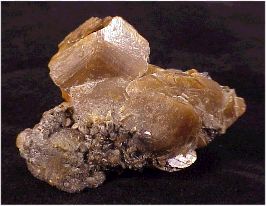The Mineral siderite

Siderite belongs to the calcite group of minerals, a group of related carbonates that are isomorphous with one another. They are similar in many physical properties, and may partially or fully replace one another, forming a solid solution series. All members of the calcite group crystallize in the trigonal system, and have perfect rhombohedral cleavage.
Siderite is easily altered to iron oxides. A brown Goethite
replacement of Siderite is common. Limonite, an amorphous
mineral, is commonly found in rhombohedral crystals, as it
frequently pseudomorphs after Siderite.
Concretionary Siderite nodules are noted for containing a wide variety of flora and fauna fossils, especially in the open-pit coal mining operations of eastern Illinois and western Indiana, where these concretions are common in the rock removed before the coal veins are exposed.
Color
Light to dark brown, yellow-brown, light yellow, yellow-green, greenish-brown, gray, and white.
Properties
Streak
White |
Hardness
3.5 - 4 |
Transparency
Rarely transparent; usually translucent to nearly opaque |
Specific Gravity
3.7 - 3.9 |
Luster
Vitreous, pearly |
Cleavage
1,3 - rhombohedral |
Fracture
Conchoidal to uneven |
Tenacity
Brittle |
Crystal Habits
Occurs as rhombohedral crystals, usually with curved, saddle-like faces, or with completely rounded faces. Seldom occurs in scalenohedral crystals. Most commonly in coxcomb and platy aggregates of curved crystals. Also massive, botryoidal, mammilary, stalactitic, oolitic, grainy, radial, fibrous, wheat sheaf, nodular, concretionary, and in rounded balls.
Additional Information
Composition
Iron carbonate, usually containing some magnesium and calcium, sometimes also magnesium, zinc, and cobalt.
|
In Group
Carbonates; Calcite Group |
Striking Features
Color and crystal forms, cleavage, and white streak |
Environment
In sedimentary beds, medium and low temperature hydrothermal ore veins, and in nepheline syenite pegmatites.
|
Rock Type
Igneous, Sedimentary, Metamorphic |
Varieties
-
Oligonite, also known as Oligon Spar, is a manganese rich variety of Siderite, containing a greater amount of iron over manganese. Its chemical formula is (Fe,Mn)CO3.
-
Sideroplesite, also known as Magniosiderite, is a magnesium rich variety of Siderite, containing a greater amount of iron over magnesium. Its chemical formula is (Fe,Mg)CO3.
Uses
Siderite is an ore of iron in some iron deposits.
Noteworthy Localities
Siderite is a common mineral and is found worldwide in many different environments. Only the most noteworthy will be mentioned here. Classic Siderite occurrences in Europe include Neudorf in the Harz Mountains, Germany; and Panasqueira, Portugal. Excellent gemmy greenish crystals come from Isere, (especially at Allevard), France. In Romania, fine Siderite has come from the ore mines of Mamarues Co., especially at Kapnik and the Turt Mine. In, England specimens have come from the Carn Brea area, in Cornwall.
Platy Siderite crystals have been abundant in China at the Yaogangxian Mine, Hunan Province. Odd, ball shaped Siderite has come from Dal'negorsk, Primorskiy Kray, Russia. Excellent Siderite pseudomorphs after Calcite come from Aggeneys, Northern Cape Province, South Africa.
In South America, some of the best examples of this mineral, in transparent gemmy form, is Morro Velho, Nova Lima, Minas Gerais, Brazil. Large and usually dark brown crystals come from the Julcani District, Huancavelica, Peru; and modified gemmy crystals from the Siete Suyos Mine, Atocha-Quechisla, Potosi, Bolivia. In Ivigtut, Greenland, Siderite crystals were found associated with the rare mineral Cryolite. Canada has produced excellent examples of this mineral at Mont St. Hilaire, Quebec.
In the U.S., good Siderite comes from a vein in Roxbury, Litchfield Co., Connecticut, with some specimens altered to Limonite. Excellent crystals have been found in the Eagle mine, Gilman Co., Colorado; Bisbee, Cochise Co., Arizona; Kellogg, Shoshone Co., Idaho; and Hiddenite, Alexander Co., North Carolina.
Distingushing Similar Minerals
Dolomite - Lighter in weight, does not become attracted to magnetic fields when heated. Difficult to distinguish by appearance alone.
Calcite - Lighter in weight.
Sphalerite - Different cleavage, doesn't effervesce in hydrochloric acid, does not become magnetic when heated.
Chabazite - Usually occurs in different mineral environments.